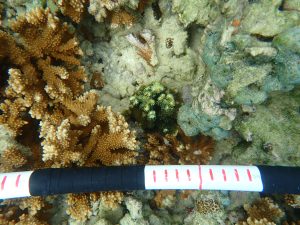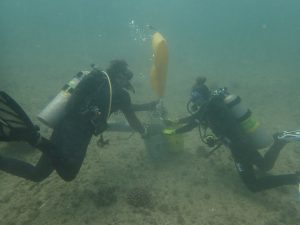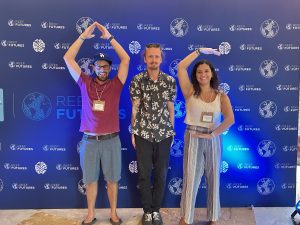Aquatic Invasive Species Team Quarterly Update (2024 Q4)
October 2024 – December 2024
Invasive Algae Management and Coral Restoration
- The AIS team outplanted 24,300 urchins to Kāneʻohe Bay as part of continued efforts to mitigate invasive algae. Read more about urchin outplanting as a part of the Cape Flattery Settlement Restoration project here.
- Continued to assist the DAR urchin hatchery with broodstock collection, spat counts, and harvesting.
- The AIS team monitored 298 coral modules outplanted by the Hawaiʻi Coral Restoration Nursery at two outplant sites located on the south shore of Oʻahu: Kakaʻako and Reef Runway. Modules are monitored regularly over the 5 years following outplanting.
- Retrained employees on the “Super Sucker” system to anticipate invasive algae removal in Kāneʻohe Bay. Applied for a Special Activity Permit for operations.
Rapid Response

Invasive Montipora cf. stellata growing in Kāne‘ohe Bay near native Montipora capitata.
- Performed orthoimagery surveys and conducted delimiting snorkel surveys in response to Anemonia manjano sighting in Kāne’ohe Bay.
- Surveyed and removed the invasive coral Montipora cf. stellata from Kāneʻohe Bay as part of a larger non-native coral removal effort that has been ongoing since 2020.
- Partnered with NOAA to perform reconnaissance of a potential Unomia stolonifera sighting outside the Pearl Harbor entrance.
Monitoring and Management
- Investigated the presence of Sarcothelia edmonsoni at Kailua Beach Park to better understand its distribution following sightings at Kualoa.
- Assisted the Fish and Habitat Monitoring team with boat operations during benthic and fish surveys in Maunalua Bay.
- Conducted SNAP surveys to monitor invasive algae in the Waikīkī Marine Life Conservation District.
Partner Agency Collaboration

DAR divers assist NOAA with rubble stabilization project at Barbers Point.
- Aided NOAA in rubble stabilization off Barbers Point by providing boat transport and dive support.
- Partnered with the U.S. Navy in disposing of an unexploded ordnance by ensuring no protected species were present on-site.
- Created an A. manjano response working group with the National Estuarine Research Reserve, Hawaiʻi Institute of Marine Biology, National Oceanic and Atmospheric Administration, Naval Facilities Engineering Systems Command (NAVFAC), and other partner organizations. Began reaching out to community organizations about the potential majano eradication.
Training and Conferences
- Attended and presented ongoing AIS monitoring projects at the Reef Futures conference in Riviera Maya, Mexico.

DAR AIS team members at the Reef Futures Conference.
- Completed hazardous waste operations and emergency response training at the Waimano Ridge State Laboratory.
Outreach
- Ran an outreach booth and gave a public talk on the history of invasive species and aquarium releases in Hawaiʻi at the Waikīkī Aquarium as part of the Don’t Let It Loose Amnesty Week campaign.
- Presented on the Kapalama/Flattery urchin outplant project at the second annual ‘Āina Momona event in Lā’ie.
- Created several A. manjano informational flyers and distributed them to various tour companies, rental organizations, and yacht clubs.
- Presented to students at the Hawai’i Technology Academy on the issues of invasive species in Hawai’i.
Personnel
- Hired Kate Gonzalez as an Aquatic Biologist II.
- Hired Richard Chen as a Senior Habitat and Fish Monitoring Technician.